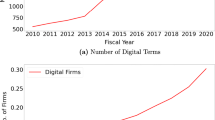Abstract
This paper provides an extensive international analysis of the cross-sectional return predictive power of a variety of firm-level profitability measures, calculated from different combinations of measures of earnings and scaling variables. We show that this cross-sectional predictive relation is more pronounced when profit is measured by gross profit and when profits are scaled by enterprise value or market value of equity. Our findings support the hypotheses that the predictive power of “profits-to-market price” factor is partly attributable to stock mispricing arising from systematic behavioral biases and partly to the choice of a “clean” measure of earnings.
Similar content being viewed by others
Notes
Chiu and Haight (2020) show that modified earnings variables with lower susceptibility to signal weakening due to investors’ learning exhibit rates of return attenuation that are 30–64% lower than rates for bottom-line earnings variables. They conclude that while investor learning is apparent in the data, learning efforts to date have been suboptimal at exploiting profitability signals within firms’ earnings streams.
Novy-Marx (2013) uses book assets as the deflator and argues that “scaling by a market based measure conflates the productivity proxy with book-to-market”. We feel that this is ultimately an empirical question.
OI of a bank is measured as total interest income plus non-interest income, minus total interest expense, non-interest expense and provision for loan losses.
EBIT as pre-tax income plus interest expense on debt minus interest capitalized.
For firms with more than one type of ordinary shares, ME represents the product of the price per share of the primary issue and the sum of listed and unlisted common equivalent shares.
For banks, insurance companies and all other industries, cash represents cash and due from banks, cash, and cash and short term investments, respectively.
Throughout the paper, we calculate t-statistics (t-stat) using the Newey-West (1987) procedure with six lags. We use 5% as our statistical significance level and present significant values in bold.
To save space in the paper, we report the average slope coefficients of the profitability variables. The results of the control variables are available upon request.
These findings are consistent with Chiao et al. (2005) who show that firm size and book-to-market effects cannot fully explain the cross-sectional return variation driven by investors’ mispricing in the Japanese stock market.
We focus on the North American sample because the mispricing factors are not available for other regions.
We focus on the four profitability variables with earnings measured by gross profit (GP) in this section because Sect. 4 shows that the return predictive power of the other profitability proxies with earnings measured by operating income (OI) and EBIT are statistically insignificant for the North American sample.
References
Asness CS, Tobias JM, Lasse HP (2013) Value and momentum everywhere. J Finance 56:929–985
Ball R, Gerakos J, Linnainmaa J, Nikolaev V (2015) Deflating profitability. J Finance Econ 117:225–248
Ball R, Gerakos J, Linnainmaa J, Nikolaev V (2016) Accruals, cash flows, and operating profitability in the cross section of stock returns. J Finance Econ 121:28–45
Barberis N, Shleifer A, Vishny R (1998) A model of investor sentiment. J Finance Econ 49:307–343
Cakici N (2015) The five-factor fama-french model: international evidence. Working Paper
Cakici N, Tan S (2014) Size, value, and momentum in developed country equity returns: macroeconomic and liquidity exposures. J Int Money Finance 44:179–209
Carhart M (1997) On persistence of mutual fund performance. J Finance 52:57–82
Chiao C, Cheng DC, Hung W (2005) Overreaction after controlling for size and book-to-market effects and its mimicking portfolio in Japan. Rev Quant Financ Acc 24:65–91
Chiu P-C, Haigh TD (2020) Investor learning, earnings signals, and stock returns. Rev Quant Finance Acc 54:671–698
Daniel K, Hirshleifer D, Subrahmanyam A (1998) Investor psychology and security market under- and overreactions. J Finance 53:1839–1885
Daniel K, Hirshleifer D, Subrahmanyam A (2001) Overconfidence, arbitrage, and equilibrium asset pricing. J Finance 56:921–965
Fama EF, French KR (1993) Common risk factors in the returns of stocks and bonds. J Finance Econ 33:3–56
Fama EF, French KR (1998) Value versus growth: international evidence. J Finance 53:1975–1999
Fama EF, French KR (2006) Profitability, investment and average returns. J Finance Econ 82:491–581
Fama EF, French KR (2012) Size, value, and momentum in international stock returns. J Finance Econ 105:457–472
Fama EF, French KR (2015) A five-factor asset pricing model. J Financ Econ 116:1–22
Fama EF, French KR (2017) International tests of a five-factor asset pricing model. J Finance Econ 123(3):441–463
Fama EF, MacBeth JD (1973) Risk, return and equilibrium: empirical tests. J Polit Econ 51:55–84
La Rafael P (1996) Expectations and the cross-section of stock returns. J Finance 51:1715–1742
La Rafael P, Lakonishok J, Shleifer A, Vishny RW (1997) Further evidence on market efficiency. J Finance 52:859–874
Lakonishok J, Shleifer A, Vishny RW (1994) Contrarian investment, extrapolation, and risk. J Finance 49:1541–1578
Newey WK, West KD (1987) A simple, positive-definite, heteroscedasticity and autocorrelation consistent covariance matrix. Econometrica 55:703–708
Novy-Marx R (2013) The other side of value: the gross profitability premium. J Finance Econ 108:1–28
Stambaugh RF, Yuan Yu (2017) Mispricing factors. Rev Finan Stud 30:1270–1315
Sundaram AK, Logue DE (1996) Valuation effects of foreign company listings on U.S. exchanges. J Int Bus Stud 27:67–88
Acknowledgements
The authors gratefully acknowledge the Summer Research Grants from the Gabelli School of Business.
Author information
Authors and Affiliations
Corresponding author
Additional information
Publisher's Note
Springer Nature remains neutral with regard to jurisdictional claims in published maps and institutional affiliations.
Rights and permissions
About this article
Cite this article
Cakici, N., Chatterjee, S., Tang, Y. et al. Alternative profitability measures and cross-section of expected stock returns: international evidence. Rev Quant Finan Acc 56, 369–391 (2021). https://doi.org/10.1007/s11156-020-00897-7
Published:
Issue Date:
DOI: https://doi.org/10.1007/s11156-020-00897-7



